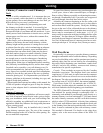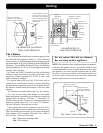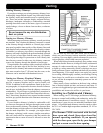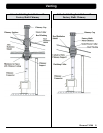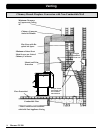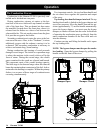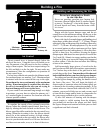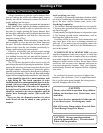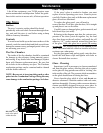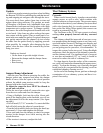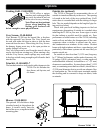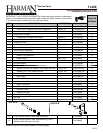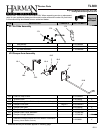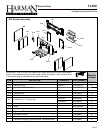
Harman TL300
18
Always remember to open the bypass damper when
you are loading, this allows the exhaust gases to pass
directly into the ue outlet and reduces the chance of
smoke spillage into the room.
Reloading: Once you have prepared and maintained
a thick charcoal bed, and the secondary combustion is
established, you should be able to reload the stove at
any time by simply opening the bypass damper, then
the load door, adding fuel and closing the door then the
damper. This depends on coal bed size, load size and
moisture content of fuel.
Removing Ashes: Before reloading, empty the ash
pan (remember to close the ash door while emptying
the pan). The ashes should be the coolest at this time.
Remove ashes from the re chamber periodically by
raking a poker across the bottom grates.
Excessive ash buildup can prevent proper venting
of exhaust gases. Do not allow the ash pan to over-ll.
Ash buildup between the ash pan and the bottom of
the grate can cause the grate to overheat and wear out
prematurely.
The TL300 was designed to allow access to the ash
pan without the need for opening the main door. Before
opening the ash door and removing the ash pan, open
the bypass damper. Wearing heavy protective gloves,
open the ash door and remove the ash pan by pulling it
forward by the handle. Close the ash door and damper
bypass before taking the ashes outside for safe disposal.
Ashes should be placed in a metal container with
a tight tting lid. The closed container of ashes
should be placed on a noncombustible oor or on the
ground, well away from all combustible materials,
pending nal disposal. If the ashes are disposed of
by burial in soil or otherwise locally dispersed, they
should be retained in the closed container until all
cinders have thoroughly cooled. (This could take
days).
Never use the ash disposal container for other
trash. Wood ash can be added to your garden or
compost.g
Building and Maintaining the Fire Cont.
As you begin to operate your stove at higher tem-
peratures, you will notice a “hot” or unpleasant smell;
this is just the paint going through the curing process,
and will disappear after a few res.
CAUTION
The stove is hot while in operation. Keep children,
clothing and furniture away. Contact may cause
skin burns.
Never leave the stove unattended if either the ash
or load door is open. Overring may result.
Risk of Excessive Temperatures. Keep Ash Door
Closed During Firing of the Heater.
CAUTION: Always wear re-resistant
gloves to operate the stove. The air control
is hot while in operation.
Avoid overring your stove.
Overring is a potentially hazardous situation which
can lead to overheating of combustible materials, dam-
age to the stove, and in extreme cases, cause a re.
Overring is caused by:
1. Too much air owing through the stove too quickly.
2. You may have positioned the primary air control lever
too far to the right.
3. Inadvertently leaving the damper or ash pan door open
4. Not keeping up with routine maintenance, such as
checking door gaskets for wear.
Overring results in excessive fuel consumption, and
may cause parts of the stove or chimney connector to
glow red. If you notice signs of overring, reduce the
air supply to the re, and review the Maintenance sec-
tion in this manual.
IN THE EVENT OF A CHIMNEY FIRE, call your
local re department; make sure everyone is safely out
of the house. Reduce the air intake of the stove as much
as possible using the air control lever; close the bypass
damper to further restrict air ow. Do not throw water
on the re; this can cause stove damage and create an
even more dangerous situation. Have your chimney
professionally cleaned and inspected before relighting
your stove.



